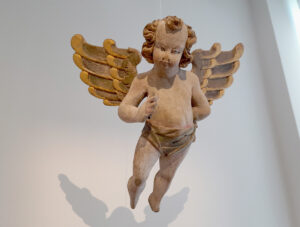Introduction
What is art? The question has been discussed for centuries, The attempts to answer this have varied and will probably continue to do so. We have submerged into the collection of Halland Art Museum, which consists of everything from paintings and sculptures that we traditionally refer to as art, to archeological fragments, handicrafts and applicances.
Here is an early painting by Olle Bærtling, a semi-abstract landscape seen from above. The colours are contrasting with a vibrantly blue sea and a yellowish green piece of land. To the left of the painting is Ulla-Stina Wikander´s sculptural installation in three pieces. It consists of a punching bag, boxing gloves and boxing boots. They are clad in cross-stitch embroidered fabrics, which the artist has collected. The motifs show women in 18th and 19th century clothing. ”I can´t take it any more” is the title of the piece and it talks about men´s physical and psychological violence towards women. The objects were initially factory made to be used in martial arts. But they were transformed into art when the artist wrapped them in cross stitch embroideries, which traditionally is percieved as a feminine and non-violent habit.
On display in a glass showcase, covering the rear wall, are sixty ceramic objects, mainly pottery. They can be viewed as a cross section of the museum´s collection and give a realistic idea of what it looks like in our warehouse.
Especially during the 18th and 19th centuries, there where many potters in Halland. The region has plenty of natural clay and the tradition lives on today. Many of the plates and bowls are beautifully decorated with animals and figures, which was typical for the region and also relates to the style on our painted hanging tapestries. Most would probably consider this arts and crafts, as the cross stitch embroidery on Ulla-Stina Wikanders boxing gear.
Olle Baertlings painting has the title Borderland. It can relate to Halland´s history – at times belonging to Denmark, at times to Sweden – always on national borders.
But it can also apply to the definition of art, something that cannot be defined within clear and strict boundaries.
The exhibition consists of four sections: ”The visually remarkable”, ”Art and Science”, ”Halland” and ”Collecting”, but the borders in between are also fluent.
Our journey of exploring the collection and the attempts of defining art have only just begun. We look forward to continuing. What is art for you? And why?








